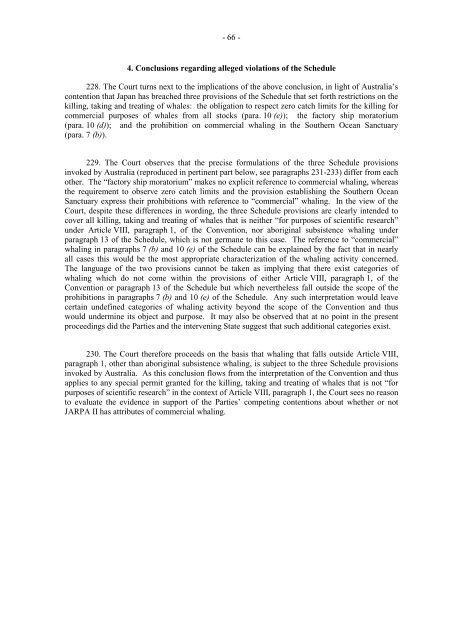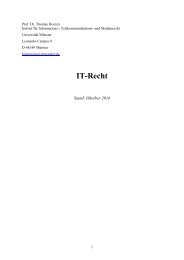3d4yVkKMl
3d4yVkKMl
3d4yVkKMl
You also want an ePaper? Increase the reach of your titles
YUMPU automatically turns print PDFs into web optimized ePapers that Google loves.
- 66 -<br />
4. Conclusions regarding alleged violations of the Schedule<br />
228. The Court turns next to the implications of the above conclusion, in light of Australia’s<br />
contention that Japan has breached three provisions of the Schedule that set forth restrictions on the<br />
killing, taking and treating of whales: the obligation to respect zero catch limits for the killing for<br />
commercial purposes of whales from all stocks (para. 10 (e)); the factory ship moratorium<br />
(para. 10 (d)); and the prohibition on commercial whaling in the Southern Ocean Sanctuary<br />
(para. 7 (b)).<br />
229. The Court observes that the precise formulations of the three Schedule provisions<br />
invoked by Australia (reproduced in pertinent part below, see paragraphs 231-233) differ from each<br />
other. The “factory ship moratorium” makes no explicit reference to commercial whaling, whereas<br />
the requirement to observe zero catch limits and the provision establishing the Southern Ocean<br />
Sanctuary express their prohibitions with reference to “commercial” whaling. In the view of the<br />
Court, despite these differences in wording, the three Schedule provisions are clearly intended to<br />
cover all killing, taking and treating of whales that is neither “for purposes of scientific research”<br />
under Article VIII, paragraph 1, of the Convention, nor aboriginal subsistence whaling under<br />
paragraph 13 of the Schedule, which is not germane to this case. The reference to “commercial”<br />
whaling in paragraphs 7 (b) and 10 (e) of the Schedule can be explained by the fact that in nearly<br />
all cases this would be the most appropriate characterization of the whaling activity concerned.<br />
The language of the two provisions cannot be taken as implying that there exist categories of<br />
whaling which do not come within the provisions of either Article VIII, paragraph 1, of the<br />
Convention or paragraph 13 of the Schedule but which nevertheless fall outside the scope of the<br />
prohibitions in paragraphs 7 (b) and 10 (e) of the Schedule. Any such interpretation would leave<br />
certain undefined categories of whaling activity beyond the scope of the Convention and thus<br />
would undermine its object and purpose. It may also be observed that at no point in the present<br />
proceedings did the Parties and the intervening State suggest that such additional categories exist.<br />
230. The Court therefore proceeds on the basis that whaling that falls outside Article VIII,<br />
paragraph 1, other than aboriginal subsistence whaling, is subject to the three Schedule provisions<br />
invoked by Australia. As this conclusion flows from the interpretation of the Convention and thus<br />
applies to any special permit granted for the killing, taking and treating of whales that is not “for<br />
purposes of scientific research” in the context of Article VIII, paragraph 1, the Court sees no reason<br />
to evaluate the evidence in support of the Parties’ competing contentions about whether or not<br />
JARPA II has attributes of commercial whaling.



